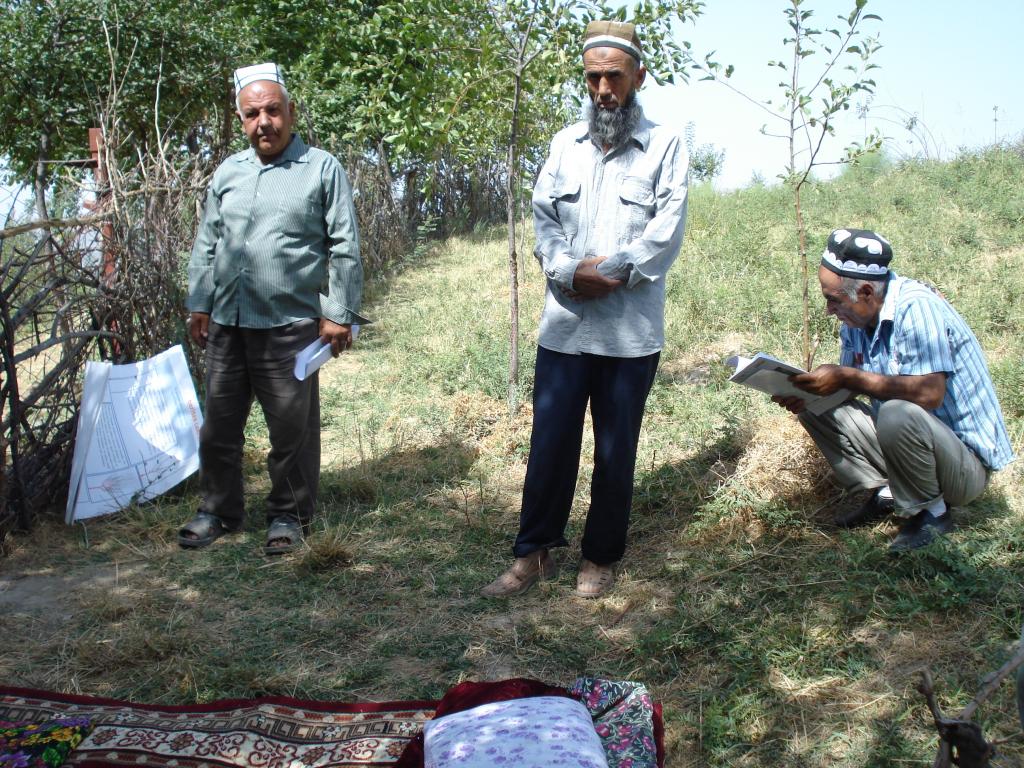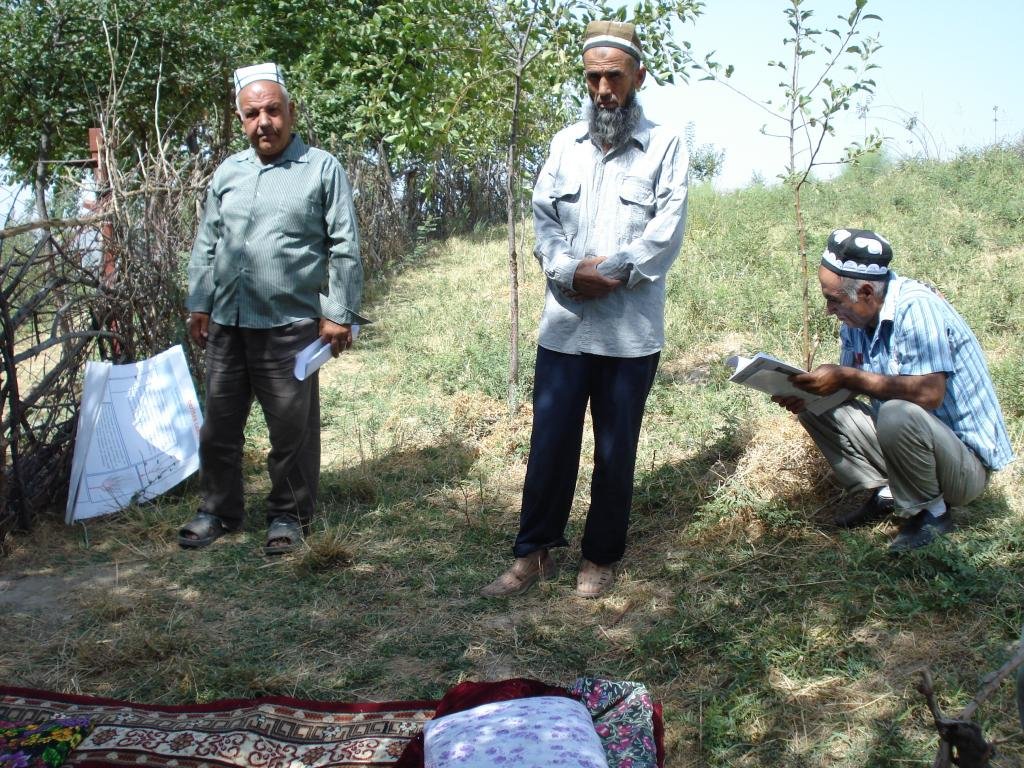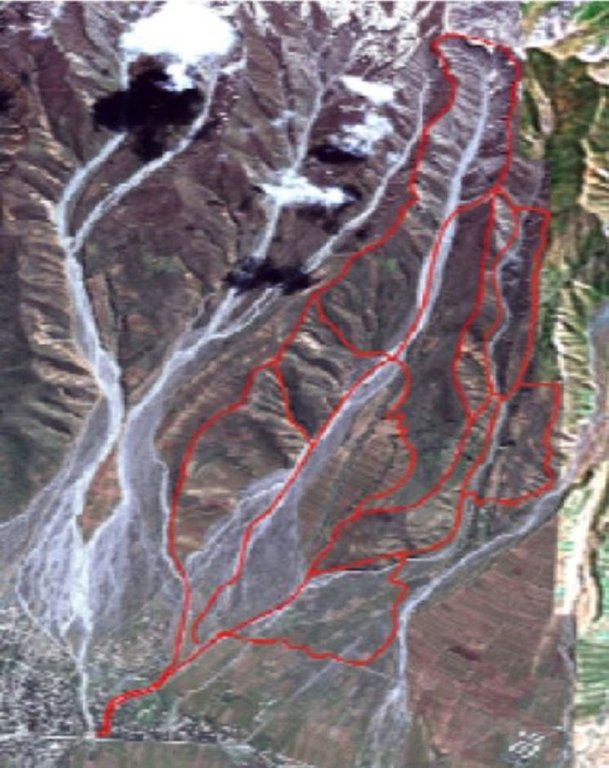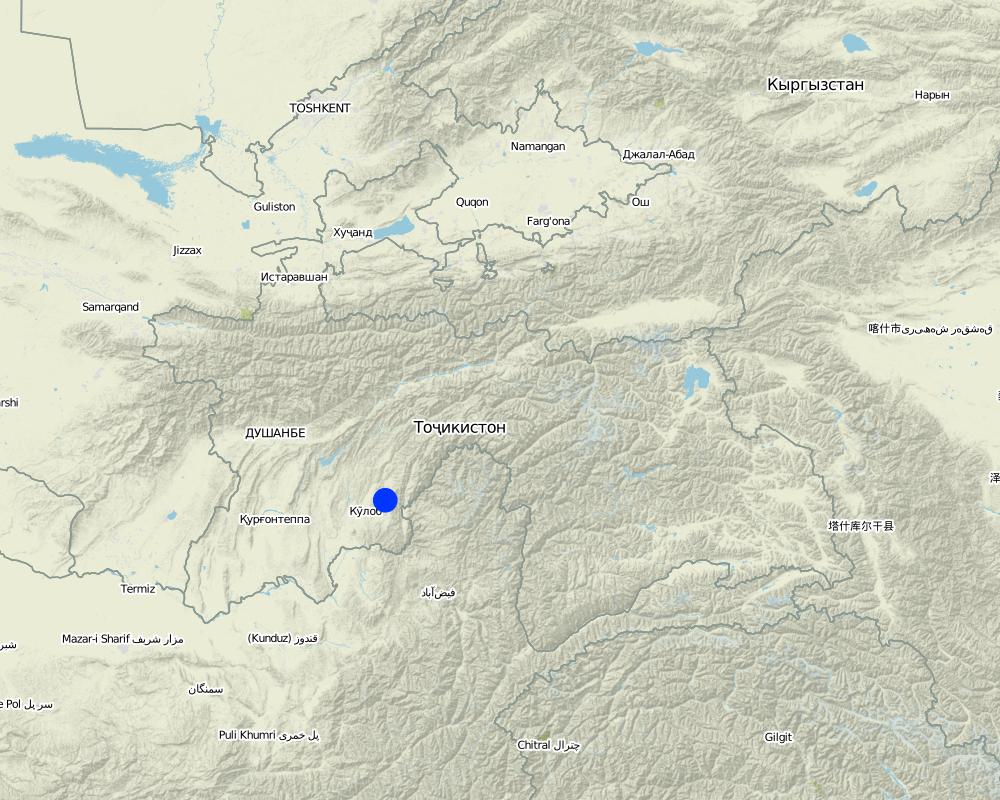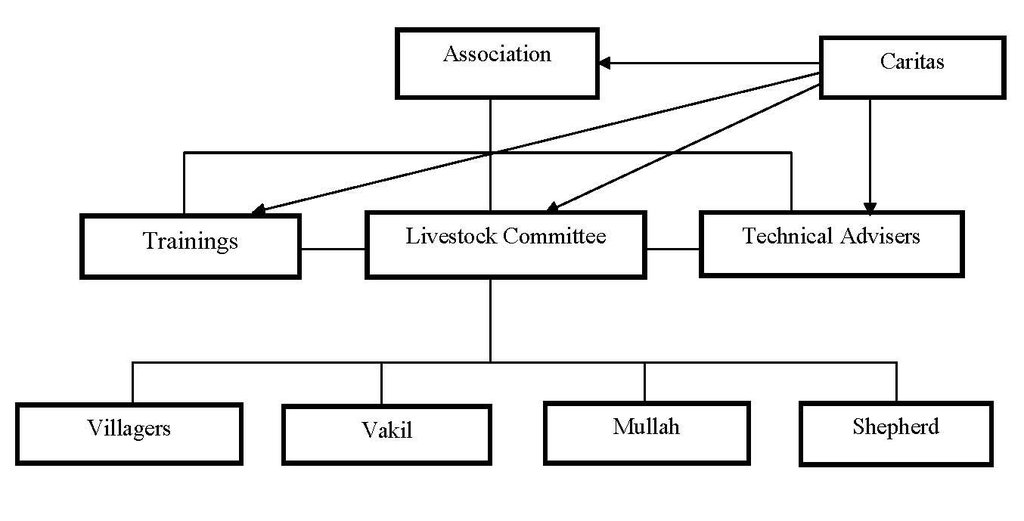Livestock Committee at Village Level [Tadjikistan]
- Création :
- Mise à jour :
- Compilateur : Sa'dy Odinashoev
- Rédacteur : –
- Examinateur : David Streiff
Кумитаи чорврдори дар сатхи деха
approaches_2435 - Tadjikistan
Voir les sections
Développer tout Réduire tout1. Informations générales
1.2 Coordonnées des personnes-ressources et des institutions impliquées dans l'évaluation et la documentation de l'Approche
1.3 Conditions relatives à l'utilisation par WOCAT des données documentées
Quand les données ont-elles été compilées (sur le terrain)?
16/08/2010
Le compilateur et la(les) personne(s) ressource(s) acceptent les conditions relatives à l'utilisation par WOCAT des données documentées:
Oui
1.4 Références au(x) questionnaire(s) sur les Technologies de GDT
2. Description de l'Approche de GDT
2.1 Courte description de l'Approche
Livestock committees were established with the goal to improve livestock health as well as natural resource management in the watersheds where the village pastures were situated. Livestock committees in the Muminabad district are organised at village level and coordinate their activities through the registered livestock association at district level.
2.2 Description détaillée de l'Approche
Description détaillée de l'Approche:
Aims / objectives: This approach applied by Caritas Switzerland, aimed to improve natural resource management in the watersheds through an organised effort of livestock owners. It encourages preventive measures against soil erosion by providing incentives for beneficiaries at community level. The process is managed by the livestock committees, who represent the animal owners at village level. The committees are responsible for organising livestock owners and managing the village pastures by applying rotational grazing principles, establishment of water points and rest places, ensuring safe paths for animals and easy access to pasture lands.
Stages of implementation: The project encompasses the following steps: 1) Competitive call for project proposals to improve livestock and pasture management through villager's efforts, 2) Expression of interest from community members to participate in the competition, 3) Development of project proposals from villagers with assistance of technical staff from the implementing agency (Caritas), 4) Selection and notification of winners, confirmation of village funding commitments, 5) A village general meeting for the inception of project and laying the foundation for the livestock committee, 6) Formalisation of partnership agreement with donor (signed agreements for project implementation), 7) Project implementation transfer into livestock committee’s responsibility, 8) Technical assistance through training and workshops, monitored by the implementing agency (Caritas), 9) Strengthening of the livestock committee as a community based organisation, 10) follow up and continued activity of livestock committee through other projects and self organised activities among livestock owners.
Role of stakeholders: Various locals and village members are essential is assisting with the success of the project; The religious head (mullah) acts as a promoter of idea and mobilises the community through developing villager's interest; the village informal leader (vakil), helps to coordinate the activities; local organisations assist in informing and bringing people together for the meetings. The livestock committee consists of five members, including the appointed head shepherd. This has proven to be an effective size group. The main tasks of this committee include; mapping the pasture lands, organising rotational schemes, informing and training livestock owners of methods to improving pasture grazing, keeping villagers informed, establishing and collecting membership fees, keeping the accounts for the organisation, and application of funds (own or donor’s), develop new ideas and project proposals for further land improvement projects.
Other important information: The villagers are responsible for the labour contribution during the construction of water points or paths/roads. They pay membership fees, which cover the shepherd’s salary and the committee’s activities. They are kept informed of pasture grazing schemes, and control the performance of the committee.
2.3 Photos de l'approche
2.5 Pays/ région/ lieux où l'Approche a été appliquée
Pays:
Tadjikistan
Région/ Etat/ Province:
Khatlon
Autres spécifications du lieu :
Muminabad
Map
×2.6 Dates de début et de fin de l'Approche
Indiquez l'année de démarrage:
2004
Date (année) de fin de l'Approche (si l'Approche n'est plus appliquée):
2010
2.7 Type d'Approche
- fondé sur un projet/ programme
2.8 Principaux objectifs de l'Approche
The Approach focused mainly on SLM with other activities (Improve the health of livestock to water, safe roads to pasture and rest places)
To implement a responsible body to manage the common pasture land in the village, and improve conditions for livestock husbandry.
The SLM Approach addressed the following problems: Implementation of pasture projects and their sustainability. Little awareness and capacity in the field of sustainable pasture management among villagers, which hampers implementation of pasture projects.
2.9 Conditions favorisant ou entravant la mise en œuvre de la(des) Technologie(s) appliquée(s) sous l'Approche
normes et valeurs sociales/ culturelles/ religieuses
- entrave
hierarchical society, individual villagers wait for the religious or governmental leader to make decisions
Treatment through the SLM Approach: Livestock committee to coordinate with the leaders of the society
disponibilité/ accès aux ressources et services financiers
- entrave
no funds available to pay a herder
Treatment through the SLM Approach: monthly contributions from the villagers
cadre institutionnel
- entrave
no formal organisation for management of the common pasture land at the village level
Treatment through the SLM Approach: village livestock committees
cadre juridique (régime foncier, droits d'utilisation des terres et de l'eau)
- favorise
The existing land ownership, land use rights / water rights greatly helped the approach implementation: common management of common land by the livestock committee
- entrave
unclear situation with regard to water use rights
Treatment through the SLM Approach: village negotiations are facilitated by Caritas Switzerland and the livestock committee
connaissances sur la GDT, accès aux supports techniques
- entrave
limited access to technical knowledge regarding the setup of a water distribution system
Treatment through the SLM Approach: technical advice provided by specialists from Caritas Switzerland
charge de travail, disponibilité de la main-d'œuvre
- entrave
pasture improvement projects are too large for single people or families
Treatment through the SLM Approach: joint effort of the whole village
3. Participation et rôles des parties prenantes impliquées dans l'Approche
3.1 Parties prenantes impliquées dans l'Approche et rôles
- exploitants locaux des terres / communautés locales
all community members are involved
everybody can participate, disadvantaged groups have equal access
- Spécialistes de la GDT/ conseillers agricoles
international specialists
technical advisors are all male
- ONG
3.2 Participation des exploitants locaux des terres/ communautés locales aux différentes phases de l'Approche
| Participation des exploitants locaux des terres/ communautés locales | Spécifiez qui était impliqué et décrivez les activités | |
|---|---|---|
| initiation/ motivation | interactive | Projects are elaborated by villagers with support of an international NGO |
| planification | interactive | village meetings, district meetings and proposal presentations |
| mise en œuvre | soutien extérieur | Cost sharing is from 80:20 up to 50:50. The village contributes the work force, stones and seedlings. Pipes and knowledge are provided externally. |
| suivi/ évaluation | interactive | members of the livestock committee and international NGOs |
| Research | aucun |
3.3 Diagramme/ organigramme (si disponible)
Description:
This organisational chart shows how the approach works at village level.
Auteur:
Sady Odinashoev (Muminabad, Tajikistan)
3.4 Prises de décision pour la sélection de la Technologie/ des Technologies
Indiquez qui a décidé de la sélection de la Technologie/ des Technologies à mettre en œuvre:
- principalement les spécialistes de la GDT, après consultation des exploitants des terres
Expliquez:
Decisions on the method of implementing the SLM Technology were made by mainly by SLM specialists with consultation of land users
4. Soutien technique, renforcement des capacités et gestion des connaissances
4.1 Renforcement des capacités/ formation
Une formation a-t-elle été dispensée aux exploitants des terres/ autres parties prenantes?
Oui
Spécifiez qui a été formé:
- exploitants des terres
Formats de la formation:
- entre agriculteurs (d'exploitants à exploitants)
- zones de démonstration
- réunions publiques
Thèmes abordés:
Training in pasture management, rotational grazing, natural resource management and soil erosion.
4.2 Service de conseils
Les exploitants des terres ont-ils accès à un service de conseils?
Oui
Spécifiez si le service de conseils est fourni:
- dans les champs des exploitants?
Décrivez/ commentez:
Key elements: theoretical and practical workshop, monitoring visits
Advisory service is quite adequate to ensure the continuation of land conservation activities; Government and other advisory service are now quite adequate to ensure the continuation of land conservation activities. The government saw the examples of good pasture management and is interested to continue with such approaches in collaboration with the livestock association.
4.3 Renforcement des institutions (développement organisationnel)
Des institutions ont elles été mises en place ou renforcées par le biais de l'Approche?
- oui, beaucoup
Spécifiez à quel(s) niveau(x), ces institutions ont été renforcées ou mises en place:
- local
Précisez le type de soutien:
- renforcement des capacités/ formation
Donnez plus de détails:
There were trainings for this Approach
4.4 Suivi et évaluation
Le suivi et l'évaluation font ils partie de l'Approche? :
Oui
Commentaires:
technical aspects were regular monitored by project staff through observations; indicators: water distribution system
management of Approach aspects were ad hoc monitored by project staff through observations; indicators: participation in committee meetings
pasture rotation aspects were regular monitored by project staff through observations; indicators: daily observations by the shepherd from the livestock committee
There were no changes in the Approach as a result of monitoring and evaluation: None
There were few changes in the Technology as a result of monitoring and evaluation: small changes on the road construction
4.5 Recherche
La recherche a-t-elle fait partie intégrante de l’Approche?
Non
5. Financement et soutien matériel externe
5.1 Budget annuel de la composante GDT de l'Approche
Si le budget annuel précis n'est pas connu, indiquez une fourchette:
- 2 000-10 000
Commentez (par ex. principales sources de financement/ principaux bailleurs de fonds):
Approach costs were met by the following donors: International (seminars, workshops, meetings): 80.0%; local community / land user(s) (worktime, providing meeting place): 20.0%
5.2 Soutiens financiers/ matériels fournis aux exploitants des terres
Les exploitants des terres ont-ils reçu un soutien financier/ matériel pour la mise en œuvre de la Technologie/ des Technologies?
Oui
Si oui, spécifiez le(s) type(s) de soutien, les conditions et les fournisseurs:
Labour input by land users was rewarded with pipes, maps and technical support
5.3 Subventions pour des intrants spécifiques (incluant la main d'œuvre)
- équipement
| Spécifiez les intrants subventionnés | Dans quelle mesure | Spécifiez les subventions |
|---|---|---|
| outils | shovel, spades provided by village | |
- intrants agricoles
| Spécifiez les intrants subventionnés | Dans quelle mesure | Spécifiez les subventions |
|---|---|---|
| seedlings | from household gardens | |
- matériaux de construction
| Spécifiez les intrants subventionnés | Dans quelle mesure | Spécifiez les subventions |
|---|---|---|
| pierres | collected from field | |
- infrastructures
| Spécifiez les intrants subventionnés | Dans quelle mesure | Spécifiez les subventions |
|---|---|---|
| routes | entièrement financé | |
| pipes | entièrement financé | |
Si la main d'œuvre fournie par les exploitants des terres était un intrant substantiel, elle était:
- récompensée avec un autre soutien matériel
5.4 Crédits
Des crédits ont-ils été alloués à travers l'Approche pour les activités de GDT?
Non
5.5 Autres incitations ou instruments
D'autres incitations ou instruments ont-ils été utilisés pour promouvoir la mise en œuvre des Technologies de GDT?
Oui
Si oui, spécifiez:
There were trainings for this Approach for local institutions
6. Analyses d'impact et conclusions
6.1 Impacts de l'Approche
Est-ce que l'Approche a aidé les exploitants des terres à mettre en œuvre et entretenir les Technologies de GDT?
- Non
- Oui, un peu
- Oui, modérément
- Oui, beaucoup
The soil cover improved, the milk production increased and the cows became fatter and healthier.
Est-ce que l'Approche a autonomisé les groupes socialement et économiquement défavorisés?
- Non
- Oui, un peu
- Oui, modérément
- Oui, beaucoup
Everybody is benefitting in the same way.
Est-ce que l'Approche a amélioré les questions foncières et des droits d'utilisation qui entravent la mise en œuvre des Technologies?
- Non
- Oui, un peu
- Oui, modérément
- Oui, beaucoup
livestock committee negotiated access to water
Did other land users / projects adopt the Approach?
- Non
- Oui, un peu
- Oui, modérément
- Oui, beaucoup
But other organisations and the government have shown interest in these ideas.
Did the Approach lead to improved livelihoods / human well-being?
- Non
- Oui, un peu
- Oui, modérément
- Oui, beaucoup
Improvement in pastures, and milk production. Livestock has high importance as it is a large financial investment.
Did the Approach help to alleviate poverty?
- Non
- Oui, un peu
- Oui, modérément
- Oui, beaucoup
With this Approach the cows become heavier and produce more milk. These animals then achieve higher prices on the market.
6.2 Principale motivation des exploitants des terres pour mettre en œuvre la GDT
- augmenter la production
milk, meat
- augmenter la rentabilité/ bénéfice, rapport coûts-bénéfices
better food, less distance to walk for the animals
- réduire la charge de travail
6.3 Durabilité des activités de l'Approche
Les exploitants des terres peuvent-ils poursuivre ce qui a été mis en œuvre par le biais de l'Approche (sans soutien extérieur)?
- oui
Si oui, décrivez de quelle manière:
The committee and collaboration among different stakeholders are well organised and the committee is now working independently. Financial contributions per villager are quite low and villagers are willing to increase them in the future if required.
6.4 Points forts/ avantages de l'Approche
| Points forts/ avantages/ possibilités du point de vue de l'exploitant des terres |
|---|
| financial contributions of each village household creates ownership (How to sustain/ enhance this strength: Financial contributions per villager are low and can be afforded also by poor households. This assures ongoing contributions.) |
| Points forts/ avantages/ possibilités du point de vue du compilateur ou d'une autre personne ressource clé |
|---|
| workshops in the villages (How to sustain/ enhance this strength: The livestock committees are integrated in an association and this will assure continued access to information.) |
6.5 Faiblesses/ inconvénients de l'Approche et moyens de les surmonter
| Faiblesses/ inconvénients/ risques du point de vue du compilateur ou d'une autre personne ressource clé | Comment peuvent-ils être surmontés? |
|---|---|
| Less participation of the women in the workshops | To explain to the men that women should also attend. |
7. Références et liens
7.1 Méthodes/ sources d'information
- visites de terrain, enquêtes sur le terrain
- interviews/entretiens avec les exploitants des terres
Liens et modules
Développer tout Réduire toutLiens
Aucun lien
Modules
Aucun module trouvé


